Russia 2008
A not quite everyday's journey: to Russia by motorcycle in July 2008
The small pictures represent clickable links that are leading to the respective larger picture.
Back to home page
In advance I'd like to say that I know the Russian language pretty fluent (I had voluntarily selected it during school time right during the Cold War despite being a Western citizen ;-) and even after long idle time
it worked out surprisingly well (as long as hotel clerks didn't switch to English without notice ;-), whereas Anja and Volker know the cyrillic letters, but don't yet understand terribly much of the language.
Furthermore, for the conversion of cyrillic to latin letters (at city names or the like) I feel that free to in doubt bypass "official" rules and to use letters according to German pronunciation.
In the reality anyway different conversion systems are in use and also within the same (con-)text not necessarily uniformly applied (and / however e.g. Google Earth knows no similarity search
and shows also "cyrillic" places often enough only "somehow" in Latin letters) - interesting effects occur particularly with multiple consonants that contain a S. In Belarus some further variants result.
For the employed motorcycle this time the choice was the Suzuki GS650G Katana (from 1980 and thus almost 30 years old, but well conserved, with shaft drive and a fuel capacity for 450 km).

To present the further actors right now: Anja with BMW R1200GS and Volker with Suzuki DR650RSE (but they here really show up somewhat later, as:)

Because it was matching the schedule (and because one anyway should make a small test ride before such a large journey ;-), the itinerary first led to central Spain to the meeting of the Spanish motorcycle newsgroup near Teruel.

One hardly can't be absent for two or three years without facing things changed: here a newly established markstone for the Greenwich meridian at the N420.

On a railway route (which, if the Internet is right, was opened in 1942, closed in 1973, dismantled 1995, and subsequently converted into a rural path), there is some interesting engineering construction.
The small bright point above the tank bag is the other (almost three kilometers distant) end of the tunnel. But this probably has been the last passage ...

... because a year later the driveway presented itself interrupted.

An unmanned filling station, my favorite toy ;-) Which credit card or the like is being (not) accepted here?

Frown in regard of the evacuated motorail station in Narbonne.

As it proved later, this was the beginning of the (becoming effective 2009) end of the breakfast which was served in this hall for users of the French domestic motorail service
(whereof was told that merely only 15..20% were still using the night trains, whereas the utmost part takes the the TGV next morning), against the cross-border motorail trains are carrying along their own breakfast and serve it in the moving train.

A pity - when one was sitting as a big group at the small tables and the Garçon went through with two big pots and filled the cups with the requested mixture of coffee and milk, this had bean already a start of the holiday feeling ...

So far, so good - but this time the main direction is East. This signposting of an avenue is not so common in the used Federal states.
(Up to here I was still alone on the way out of Southern Germany - however, then the mobile phone usage started to specify a suitable meeting point with my rather North resp. West German fellow riders..)

Turning left shortly after crossing the Russian border into the Kaliningrad district, and then (even if it's the worse way) turning always straightforward ...

(normally one cannot miss it, but in the year before we have managed so shortly after this stone)

... one finds the remainders of the place that was named Balga during Prussian time.


Entering Kaliningrad ...

... and arriving in the city center, where (after a bit of mobile phone usage) we were picked up by a local motorcyclist.

The main event of this weekend is (again) the "Bike show" on the old airfield, where also numerous non-motorcyclists are crowding towards.

The central stage.

Particularly for this weekend (at least a part of) the company museum of the Russian motorcycle manufacturer Isch was presented.

A few general impressions of the Kaliningrad motorcycle meeting ...


... and one the numerous Schaschlik roasteries.

Also Russian motorcycles obviously already have traveled far (here with stickers from the Pyrenees etc., which might, hoewver, still origin from the ancient owners).
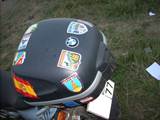
The Yamaha Super Ténéré can be found (after the general impression of this journey) in Russia significantly more frequently than Africa Twin, Transalp and other dual sport bikes together.

Naturally also self-willed special constructions may not be missing.


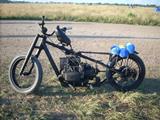
Saturday afternoon the "loose heap" forms itself to a Korso, ...

... to leave the meeting's venue ...

... and (on the way to the war memorial) to paralyze a little the traffic in Kaliningrad.

Later on Nikolai means us to follow him, and in a workshop backyard turns on a dirt road. This changes shortly thereafter into a motorway, which a former national prince not quite managed to complete during his active time
and since then was idling (OK, a fresh layer asphalt seems have to been added since then) - and nowadays serves as training ground for motorcycle acrobats.

Maxim gives a small show for us exclusively!



The eastbound road from Kaliningrad without ...

... and with avenue trees.

Next stay was Vilnius - not (only) because it was along the way, but for the Russian embassy, as Anja had inadvertently (despite request for twice) only a visa for a one-time entry, which was used up with Kaliningrad.
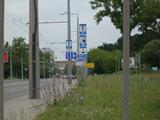
After the separation from the Soviet Union, in Lithuania (and the other Baltic states) the change over from cyrillic to latin letters had taken place. The understanding is favorable nevertheless only with restrictions.

Our night lodging in Vilnius.

City-stroll in Vilnius.




To continue riding we had decided for the road through Witjebsk, a completely uncommon itinerary for Western tourists
(who's not driving entirely around Belarus for avoidance of the additional visa, normally takes rather the way through Minsk). Remarkably this is here a gasoline pump without price counter.

The effective price calculation takes place directly at the cashier, of where from the paid quantity for the gasoline pump is released. That then however this quantity runs inevitably from the hose, is exactly the same nonsense
(with really old technology at initial Soviet times that perhaps may have been like that, but nowadays the operation of the trunk is working like in Western countries) as that the necessary quantity must be estimated exactly in advance
(one can deposit a larger amount at the cashier and come back for the change, or also in iterative approach again and again pay and refuel an additional (half) liter). And the conversion to "fill first, pay afterwards" is in full swing
(although still far from being completed everywhere). The credit card symbols, however, have here merely a decorative shape, but apart from that the Belarus are quite habitual with foreigners and their currencies,
as one can see here at the price list - a liter of premium gasoline for 80 cents, roughly half of the price of home :-) whereas in Russia almost nothing else is accepted beyond Russian rubles in cash.

A bus stop at the roadside - the associated village is located a few meters apart

and in Belarus the names are clearly written (which occurred far less common in Russia).
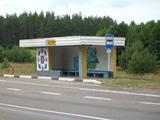
And then the middle of the Byelorussian nowhere there was this pointer to Paris - (only) during the further ride the assumption arose that this might have been a joke (also the I is written in cyrillic,
whereas the Byelorussians normally place the latin I between other cyrillic letters) or an advertising campaign (a well-known rally is known for searching a new area to take place, but I didn't see the corresponding sign to Dakar ;-).

For Western European conditions only few (roughly a tenth according to a one locally heard number) motorcyclists are on the road, but ...

... if they nevertheless pass by while one looks the road map in the outskirts of a town, then the natives gladly start to chat (and if necessary often enough escort us through the city).

In the hotel in Witjebsk.

Here it's a dual carriageway.

Dangerous road ahead (whereby the headline word comes rather from the Polish than from the Russian language).
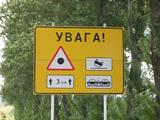

A typical timber building at the roadside.

Continue to part 2
to top of page
© 1999-2013 by
webmaster@martin-theodor-ludwig.de -
latest update 29. Sep 2013, 23:25:34
























































